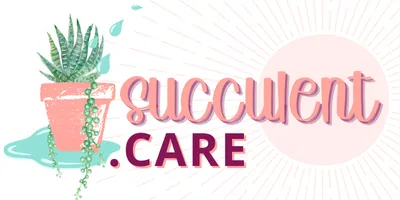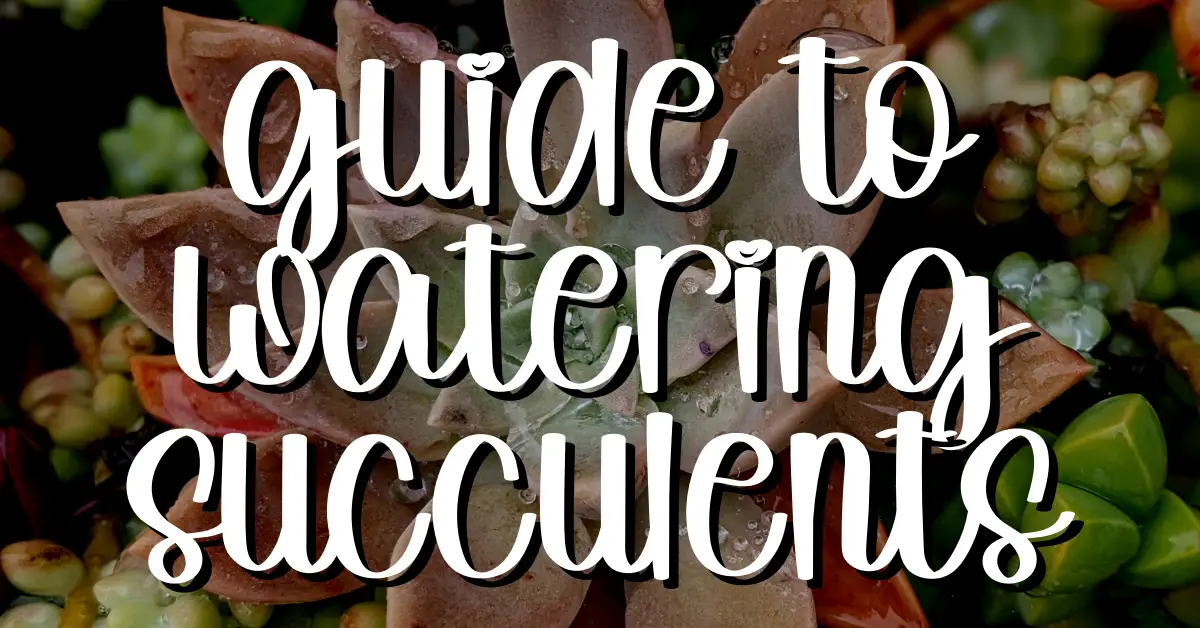To ensure that your plants thrive, it’s important to understand how to water succulents properly.
Succulents do not need a lot of water and should only be watered when the soil is completely dry to avoid overwatering, which can lead to root rot.
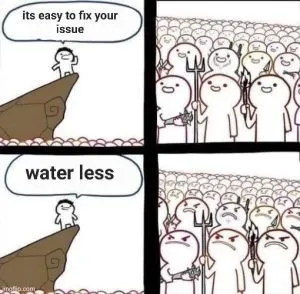
The frequency of watering varies based on the time of year, the environment (indoor or outdoor), and the type of succulent.
Additionally, proper drainage is important, so make sure to choose a pot with drainage holes or to water sparingly if the pot does not have holes.
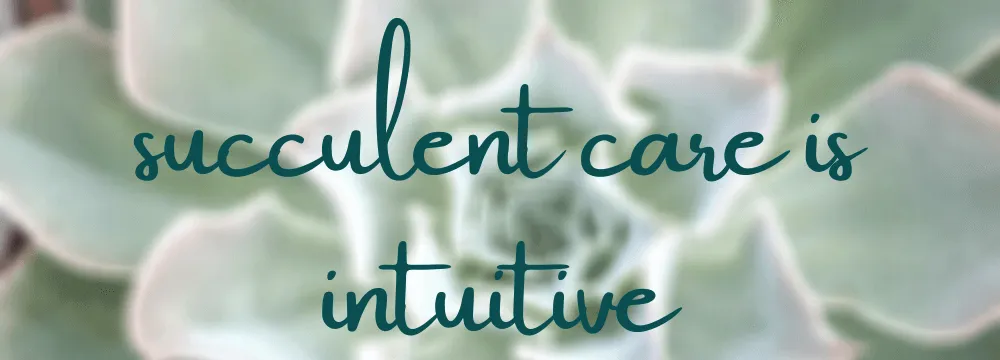
Dig in!
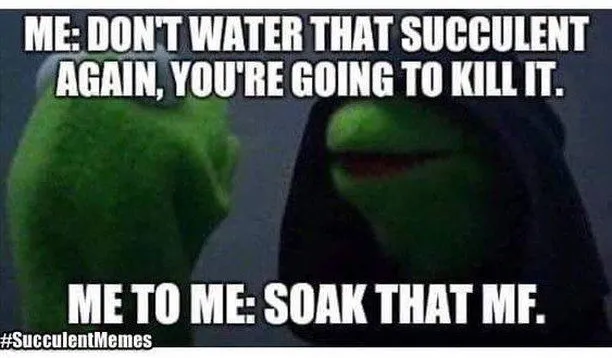
Do succulents need water?
Yes, they require hydration to thrive, but it’s important to not overwater succulents as they store water in their leaves and too much water can lead to root rot. A proper watering schedule and technique are crucial for the health of your succulents.
I will say that overwatering is the number one cause of dying succulents, so be aware of that.

How often to water succulents
The frequency of watering succulents varies based on several factors such as the species, size, environment, and season. As a general rule, most succulents should be watered once every 1-2 weeks, allowing the soil to dry out completely before the next watering. It’s important to observe the condition of your succulents and adjust the watering schedule as needed to ensure they receive the right amount of moisture.
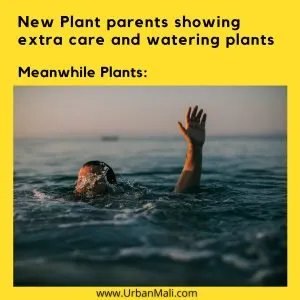
I prefer to let the succulents tell me when they need water. When I observe that my succulents starting to get dull and wrinkle is when I water them deeply. Underwatering your succulents is better than overwatering, so always err on the side of a longer watering schedule.

How much water do succulents need?
When it comes to watering succulents, it’s important to avoid giving too much or too little. A general guideline is to give your succulents a thorough watering until water flows out of the drainage holes, then allow the soil to completely dry out before watering again. The exact amount of water your succulents will need will depend on various factors such as their size, environment, and time of year. Pay attention to the appearance of your succulents, and adjust the amount of water as necessary to ensure they receive the right amount of moisture they need to survive and thrive.

When to water succulents
The best time to water succulents is when the soil is completely dry. This varies depending on various factors such as the succulent species, size, climate, and season. A good way to determine when your succulents need water is to stick your finger about an inch into the soil. If it feels dry, it’s time to water. It’s important to not wait until the leaves of your succulents start to wrinkle too much or droop, as this is a sign of overwatering or underwatering. Regularly checking the soil moisture and adjusting the watering schedule as needed will help ensure your succulents receive the proper hydration.

How to water succulents in summer
In the summer, succulents typically need to be watered more frequently than in other seasons, as the heat and increased sunlight cause the soil to dry out more quickly. As a general rule, most succulents should be watered once every 7-10 days, allowing the soil to dry out completely before the next watering. Watch the way your succulents leaves look, and adjust the watering schedule as needed. Remember, it’s better to underwater than overwater succulents, so be cautious about overwatering during the summer months. If you’re not sure, don’t water.

How to water succulents in winter
During the winter, succulents typically need to be watered less frequently than in other seasons, as the reduced light and cooler temperatures slow down their growth and water needs. As a general rule, most succulents should be watered once every 2-3 weeks, allowing the soil to dry out completely before the next watering. Watch the physical condition of your succulents, and adjust the watering schedule as needed. Remember, succulents are sensitive to overwatering, especially in the winter when the soil takes longer to dry out, so be careful not to water too frequently.

How often do you water succulents indoors?
When it comes to watering your indoor succulent plants, it’s important to not give them too much water. You should wait until the soil is completely dry before watering again. It will take much longer for succulent soil to dry out indoors so you’ll go longer in between watering your succulents. This may mean watering your succulents once every two or three weeks, depending on how dry the soil gets.
Don’t rely just on the soil telling you when to water succulents. Make sure the succulent itself is showing signs of dehydration.
To check if it’s time to water your plant, you can stick your finger about an inch deep into the soil. If it feels dry, it’s time to water. If it feels moist, wait a few more days before checking again.
It’s important to water the soil directly, not the leaves, and make sure the pot has drainage holes so excess water can drain away.
You might also like: Drainage Hole at the Bottom of The Pot: Do Succulents Need Them? The Answer Might Completely Shock You!

How to water succulents outdoors
The frequency of when you water succulents outdoors depends on a few various factors such as the species, size, environment, and season. As a general rule, most outdoor succulents should be watered once every 7-10 days during the growing season, allowing the soil to dry out completely before the next watering.
Of course, you’ll need to pay attention to the condition of your succulents leaves and stem, then adjust the watering schedule. In the winter, when succulents are dormant and not actively growing, they typically need to be watered less frequently, so be careful not to overwater succulents during this period.
You’ll notice succulent leaves falling off during dormant periods. This doesn’t necessarily mean they need more water. Outdoor conditions, such as sunlight and wind, impact the rate at which the soil dries out, so adjust the watering schedule as needed.
You might also like: Succulent Dormancy: 4 Easy Ways to Tell if Your Succulent is Going Dormant
Should you water succulents with ice cubes? No. Just no. Sure you may have heard that people do this, but when you think about how deeply and infrequently succulents like being watered you’ll think twice. They won’t die but if you water succulents with ice cubes they won’t be living their best lives.
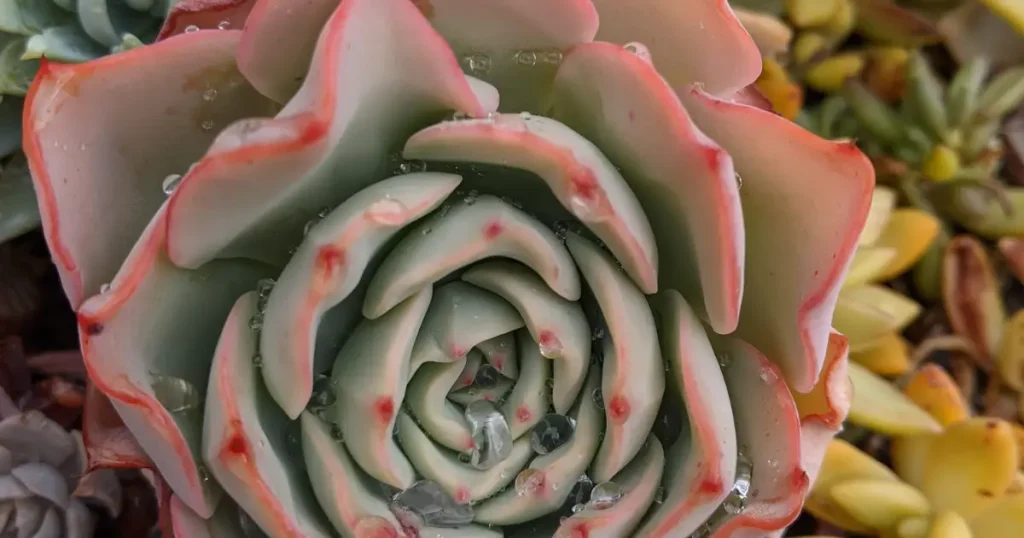
What do overwatered and underwatered succulents look like?
Underwatered succulents often display signs of stress, such as wrinkled or shrunken leaves, a dull appearance, and a sluggish growth rate.
On the other hand, overwatered succulents can show signs of root rot, including yellowing or soft, mushy leaves, a soft or mushy stem, and a foul odor. It’s important to address both under- and overwatering promptly to ensure the health and vitality of your succulents.
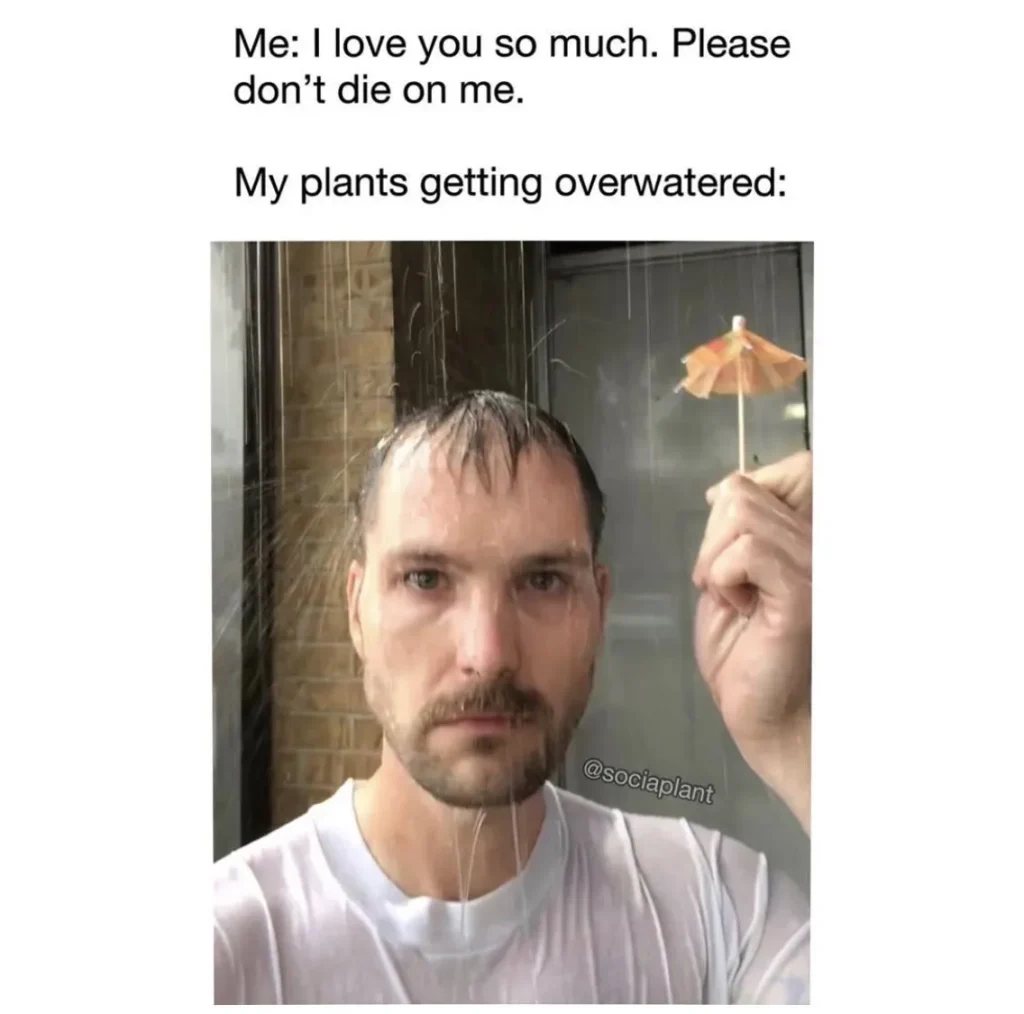
First signs of overwatering
In general, well-watered succulents will have plump, firm leaves and a healthy growth rate. When the succulent leaves falling off are still full, you might be experiencing the first signs of overwatering.
What to do when healthy leaves pop off
Hold off on watering for a while and see what happens. When succulent leaves falling off are dry and crispy from the bottom, that’s normal.
Let them tell you when they need water. Not the other way around.
Observing the condition of your succulents closely will tell you when to adjust when you water succulents and technique as needed will help keep them looking their best.
Again, it is much better to under-water succulents since they have a chance to recover.
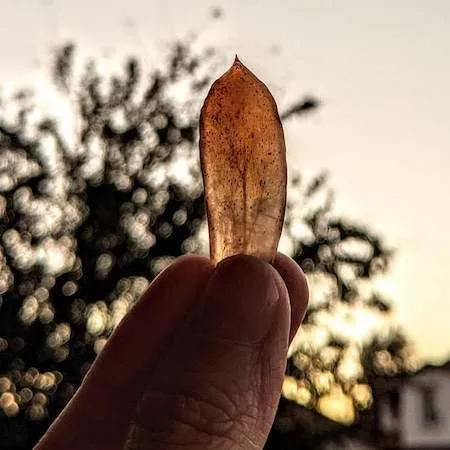
Signs of overwatering:
Leaves that pop off suddenly
Yellow leaves
Transparent leaves
Mushy, soft leaves
Black leaves or stem indicates rot
Is your succulent rotting?
If overwatering has caused your succulent’s roots to begin rotting, simply withholding water is not the only solution.
To promote healing and prevent further damage:
- Carefully remove the succulent from its pot and soil and allow the roots to air dry for a few days.
- This will not harm the plant and will give the remaining healthy roots an opportunity to “callus” or form a protective scab. Any rotted roots will naturally detach from the plant during this time.
- Once the roots have had a chance to heal, repot the succulent in soil that is slightly damp to almost dry.
- It is recommended to prolong the watering cycle slightly until the plant shows signs of healthy growth and is no longer affected by root rot.
Read more about root rot prevention here:
Root Rot in Succulents: How to Identify and Treat the Problem


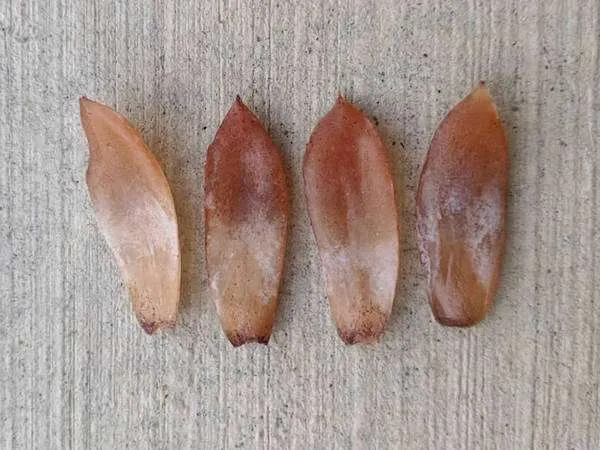
These leaves come from an overwatered succulent and have either fallen off, or I actually noticed them when doing my maintenance and pulled them off.
Why do my succulents liquify?
If your succulent leaves are getting soft and turning into a mushy, liquidy mess, it is most likely a sign of overwatering. Overwatering is the most common issue with succulent care, as these plants are adapted to survive in dry environments and don’t need frequent watering. When succulents receive too much water, their roots can become waterlogged and begin to rot, leading to the plant’s collapse and eventual liquification.
If the roots don’t rot first, the leaves will continue to store water until the cells inside burst because they can only hold a finite amount of water. Soft, transparent leaves are a key indicator.
You might also like: 10 Cactus and Succulent Adaptations: How These Incredible Plants Have Adapted to Survive in Extreme Environments
To prevent succulents from liquifying, follow proper watering techniques. Succulents should be allowed to dry out completely between waterings, and avoid watering the leaves or crown of the plant. Make sure that the soil is well-draining and that the pot has adequate drainage holes to allow excess water to escape.
If your succulent has already liquified, there is unfortunately not much that can be done to save it. Remove the plant from the soil and dispose of it to prevent the spread of any potential diseases to other plants.
To prevent this issue in the future, observe the condition of your plants more instead of acting too quickly, make sure to adjust your watering habits and ensure that your succulents are planted in well-draining soil.
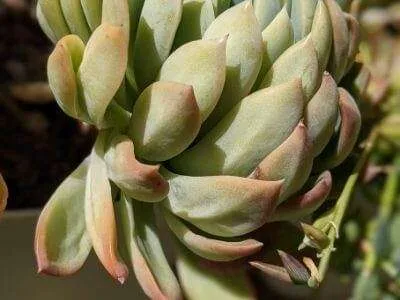
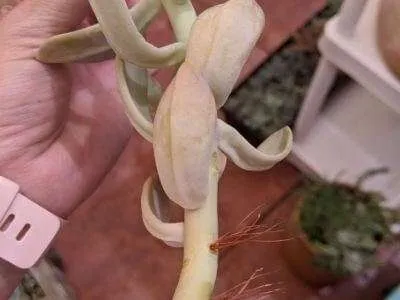
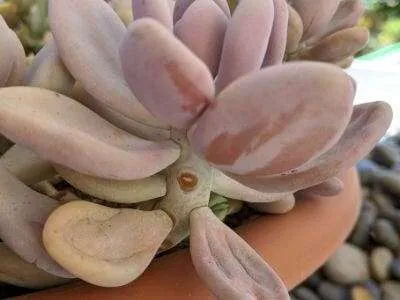
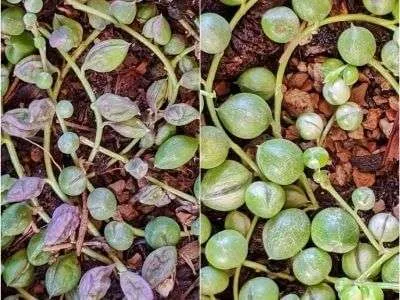
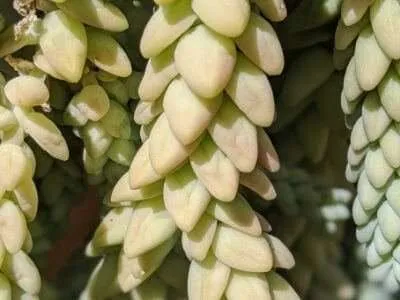
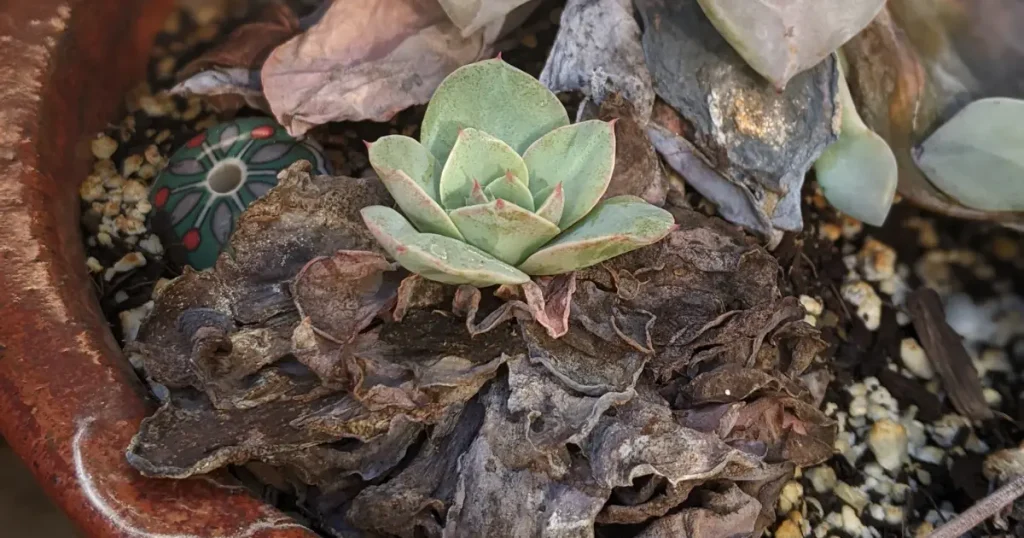
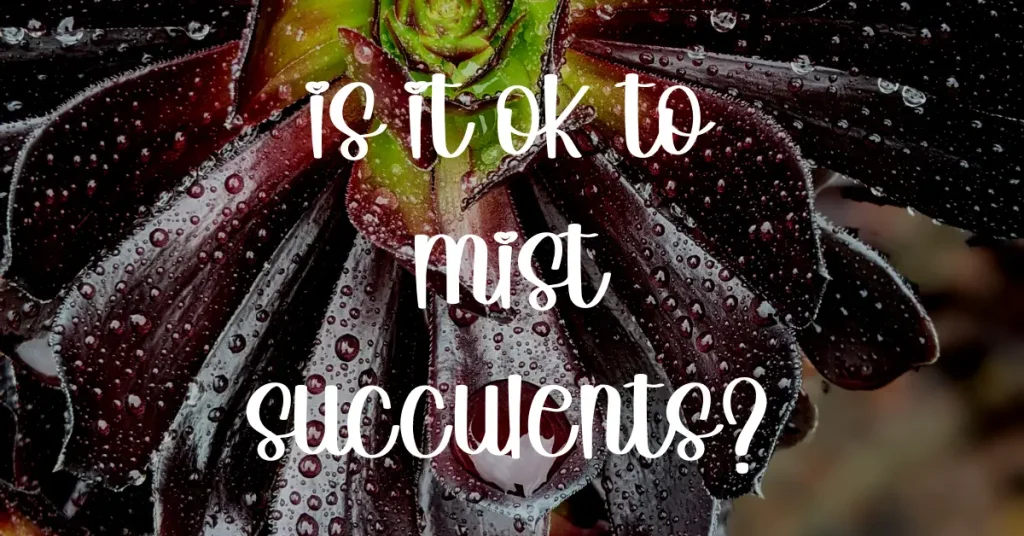
Should you mist succulents? No. Stop that!
Succulents don’t require misting, as they are adapted to arid environments and store lots of water in their leaves and roots. Misting will increase the humidity around the succulents, which can lead to issues like fungal growth and root rot. Instead of misting, it’s best to provide your succulents with the right amount of water, allowing the soil to dry out completely and waiting for signs of underwatering before the next time you water succulents.
If you live in a humid environment, you will need to provide better air circulation around your succulents to help keep the humidity levels low. Point a fan towards your succulent collection and this should suffice, but don’t be sad or surprised if your succulents start rotting anyways. That’s just how it is sometimes.
You should be using a succulent soil mix that promotes good drainage to help reduce the risk of overwatering especially if you’re already in a humid climate.

Importance of Proper Pot Size
A crucial factor in learning how to water succulents is the proper size of their pot. Overwatering is a common problem for many succulent growers, as it can lead to root rot and other damaging effects on the plant. However, the size of the pot can play a significant role in how much water is retained in the soil, and thus how much water the roots are exposed to.
A pot that is too big will hold more water for longer periods of time, increasing the risk of waterlogged soil and root rot. To avoid these issues, it is recommended to choose a pot that is just slightly bigger than the root ball of the succulent. By keeping the roots in check with a smaller pot, the plant can focus its energy on leaf growth, rather than filling the pot with an overabundance of roots.
What is the Right Pot Size for Succulents and Cacti?
A common mistake when first learning how to water succulents and cacti is using a pot that is too large. A pot that is too big can hold too much soil, leading to root rot and other issues. It’s best to choose a pot that is only slightly larger than the plant’s root ball, leaving no more than 1-2 inches of soil between the roots and the pot’s walls.
What are the Consequences of Overpotting Succulents and Cacti?
Overpotting (putting a succulent in a pot that is too big for it) is a common mistake that can lead to root rot and other issues. When the pot is too big, there are no roots in the extra portion of soil outside the existing root ball to absorb the water. This moisture can keep feeding back into the soil mass, leading to root rot and other issues. The extra soil will hold water and could potentially harbor unwanted bacteria which we know can kill our succulents.

When and how to water succulents after repotting
It’s best to wait a few days to a week after repotting succulents before watering them. This gives the succulent time to recover from the stress of being transplanted and allows the roots to settle into their new soil. The length of time to wait will depend on the size of the pot and the size of the succulent, but in general, it’s a good idea to wait until the soil has started to dry out before watering. This will help prevent overwatering, which can lead to issues like root rot.
Once you do start watering, be sure to water thoroughly, allowing the water to penetrate the soil and reach the roots. Be sure to observe the condition of the succulent and adjust the watering schedule as needed.
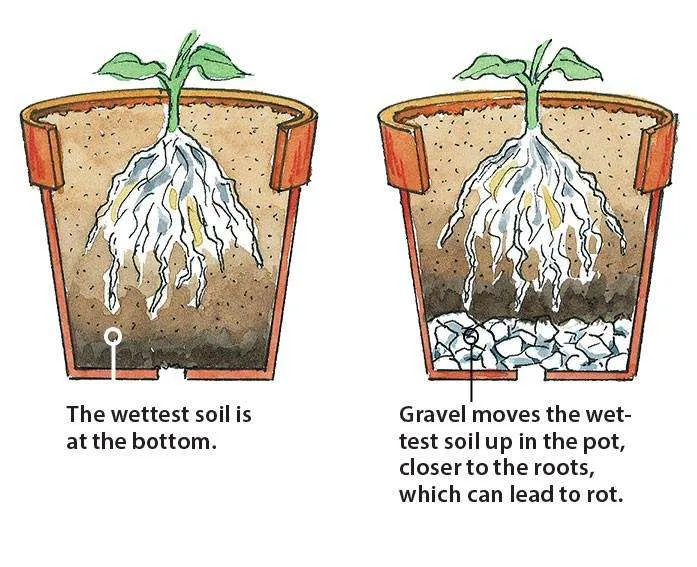
Should I put a layer of rocks at the bottom of the pot? No! Stop doing that!
Putting a full on layer of rocks at the bottom of a pot for succulents is not necessary, and can be harmful to the succulents. Rocks prevent proper drainage and lead to water accumulation in the bottom of the pot, increasing the risk of root rot. Instead of rocks, it’s better to use a high-quality, gritty succulent soil mix that promotes good drainage, allowing excess water to easily escape from the bottom of the pot.
Additionally, it’s important to choose pots with adequate drainage holes to allow water to flow out and prevent waterlogged soil. Good soil mix and proper drainage are key factors in ensuring the health and well-being of your succulents.
Pour water out of the saucer after watering. If your succulent pots have saucers to catch excess water, be sure to pour that water out after about 30 minutes. Leaving the plant sitting in water can lead to root rot. The saucer just helps contain the water while it seeps into the soil. Then discard the remaining water so no moisture is left sitting under the pot.
I will say that placing one rock over the drainage hole is fine. If I can’t find my favorite drywall tape or screen material I’ll do that instead.
Do succulents need drainage holes?
Yes, succulents do need drainage holes in the bottom of their pots. Good drainage is essential to the health of succulents.
Drainage holes allow excess water to escape from the soil, preventing overwatering, waterlogged roots and reducing the risk of root rot. When choosing a pot for your succulent, make sure it has adequate drainage holes and consider using a potting mix that promotes good drainage. Additionally, it’s a good idea to elevate the pot slightly off the surface to allow water to drain away freely, which can further enhance the succulent’s health and vitality.
Make this a habit when you’re first learning how to water succulents and you’ll be much more successful in growing succulents.
Can succulents live in only water?
No, succulents cannot live in water permanently. Succulents store water in their leaves, stems, and roots, but they still need air and proper drainage to survive.
You might also like: 10 Cactus and Succulent Adaptations: How These Incredible Plants Have Adapted to Survive in Extreme Environments
When left in standing water, succulents will quickly become waterlogged and develop root rot, which can lead to death. Instead of water, succulents need gritty, well-draining soil, bright light, and proper watering techniques to thrive.
You might also like: Root Rot in Succulents: How to Identify and Treat the Problem
How Do Succulents and Cacti Survive in the Ground with Unlimited Soil?
Succulents and cacti have adapted to survive in harsh and arid environments, making them well-equipped to handle limited soil resources in the wild. In their natural habitats, these plants have access to unlimited drainage and the soil is subject to factors such as worms, insects, microorganisms, humus, freezing and thawing, which keep the soil active and moving. This helps ensure that the soil remains healthy and doesn’t become waterlogged, which can lead to root rot.
The soil where I live in Southern California is pretty dense and sandy, so just to be safe, I amended it heavily with Turface and pumice before planting my succulents and cactus in the ground. When I’m planting cuttings in the ground, I’ll lay down some of my favorite soil mix and hold off on watering them until roots form.
Bottom watering succulents
Bottom watering (affectionally called ‘Butt Chugging’ in Facebook groups) is a method of watering succulents where the plant is set in a tray of water, allowing the water to wick up from the bottom and hydrate the roots using capillary action. Here’s how you bottom water succulents:
- Fill a shallow tray or dish with water, making sure the water level is below the bottom of the pot.
- Place the pot containing the succulent into the tray, being careful not to get water on the leaves or stem.
- Leave the pot in the tray for about 30 minutes to an hour, or until you see water coming out of the bottom of the pot.
- Remove the pot from the tray and let it drain completely.
- Repeat this process as needed, depending on the conditions in your environment and the health of your succulent.
By using this method, you’ll ensure that the roots of your succulent are getting the hydration they need with a lowered risk of root rot. It also requires that you have a drainage hole at the bottom of your pot which is a must.
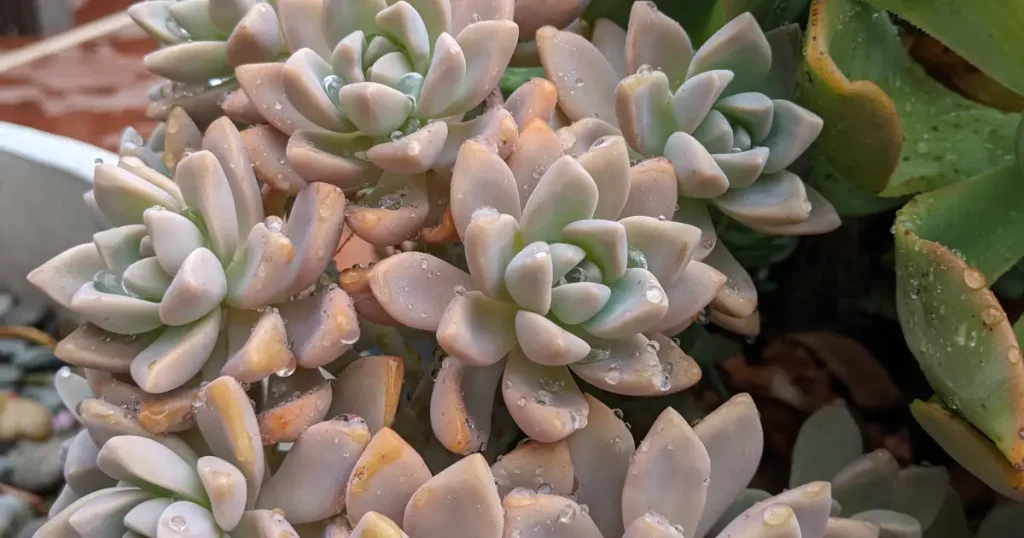
Drawbacks to bottom watering succulents
- Root Rot: If you leave the succulents in standing water for too long, the roots will begin to rot, which can kill the plant.
- Soil Erosion: Bottom watering can cause soil to erode and wash away, making it difficult for roots to anchor the plant securely in the pot.
- Lack of Oxygen: Bottom watering can also restrict the flow of oxygen to the roots, which will lead to root damage or death.
- Poor Drainage: Bottom watering creates stagnant water at the bottom of the pot, which contributes to poor drainage and lead to water-logged roots.
- Inconsistent Watering: Bottom watering can be inconsistent, as the water level at the bottom of the pot may vary depending on the size and shape of the pot, making it difficult to ensure that all plants receive an adequate amount of water.
In general, bottom watering is best used as a supplementary watering method, rather than as the primary method of watering succulents. It’s important to keep an eye on the water level and monitor the plants closely to ensure that they are not sitting in standing water for extended periods of time.
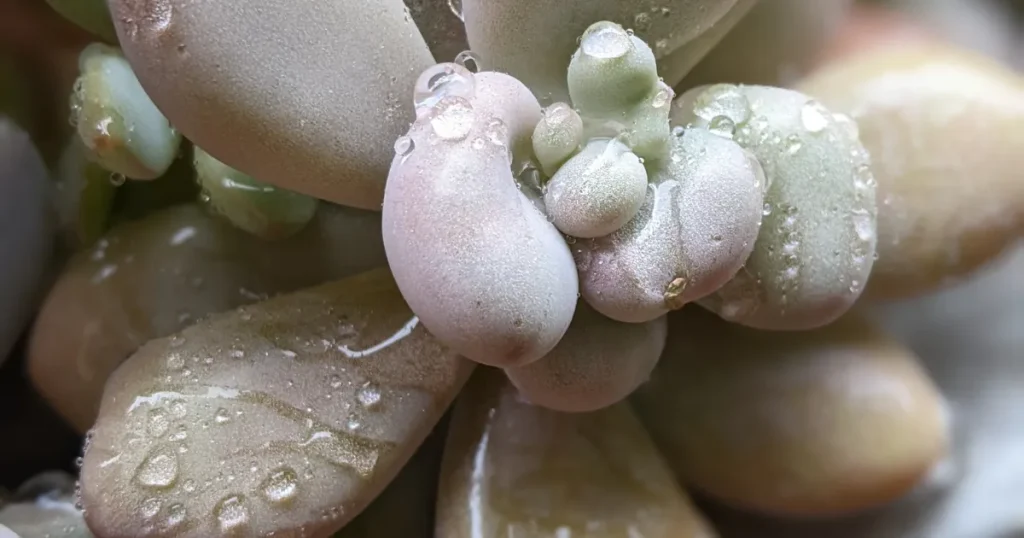
Is tap water safe with succulents?
Tap water can be safe for succulents, but it may contain minerals and chemicals that can build up over time and harm the succulent. Chlorine, fluoride, and other chemicals commonly found in tap water are toxic to succulents, leading to leaf burn and other problems. Additionally, some tap water sources have a high mineral content, which cause a buildup of salts in the soil over time and lead to root damage.
To ensure the safety of your succulents, it’s best to use distilled water or rainwater for watering. If you must use tap water, let it sit for 24 hours to allow the chemicals to evaporate before using it on your succulents. You can use a water filtration system to remove minerals and chemicals from tap water before using it on your succulents.
It’s also important to be mindful of the water you use for other purposes in your home, such as misting or cleaning the leaves, as these activities introduce chemicals and minerals to your succulents. By being mindful of the water you use and taking steps to ensure its purity, you can help to keep your succulents healthy and thriving.
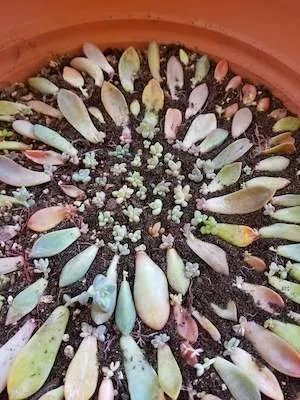
How do you water succulents during propagation?
Watering during propagation of succulents is an important aspect to consider as it can impact the success of the propagation process. When propagating succulents, it’s important to strike a balance between keeping the cuttings or offsets moist, but not too wet. Overwatering leads to root rot, which can kill the cutting, while underwatering leads to the cutting drying out and not rooting.
Here are some tips for watering succulents during propagation:
- Water sparingly:
- When propagating succulents, it’s important to water sparingly. This is the only time you should use a misting bottle to mist the cuttings or offsets lightly and avoid getting water on the leaves.
- Too much water can jostle the leaf and roots which may introduce bacteria and kill the leaf and pup.
- Use well-draining soil:
- Make sure to use a mostly inorganic, well-draining soil mix for propagating succulents to avoid water sitting in the pot and leading to root rot.
- Wait for roots to develop:
- Do not water the cuttings or offsets until you start to see roots developing. Succulents don’t absorb moisture through their leaves. This usually takes a few weeks to several months, depending on the species. Once roots have formed, gradually start watering the new succulent as you would a mature succulent.
- Keep it humid:
- While succulents generally thrive in dry environments, they need a bit of humidity to encourage rooting during propagation and to prevent the fragile roots from drying out. Keeping a humidity dome over the cuttings or using a propagating tray with a lid can help maintain the right levels of humidity.
Mistakes to avoid when watering succulents
- Overwatering: This is the most common mistake when watering succulents. Overwatering leads to root rot, which is a fatal condition that can quickly kill your succulent. Be sure to let the soil dry out between waterings and to only water the succulent when it needs it.
- Not letting the soil dry out enough: Succulents store water in their leaves and stems, so they don’t need to be watered as often as other plants. Letting the soil dry out between waterings helps to prevent root rot and encourages the succulent to grow deep roots.
- Not using a well-draining soil mix: Succulents need well-draining soil to thrive. If you’re using a soil mix that retains too much moisture, it can lead to root rot and other problems. Consider using a cactus or succulent soil mix, or adding perlite or sand to improve drainage.
- Not adjusting watering schedule based on environment: Succulents in warmer, dryer climates need to be watered more frequently, while those in cooler, damper conditions need less. Be mindful of the environment and adjust your watering schedule accordingly.
- Using water with high mineral content: Tap water can contain minerals and chemicals that build up over time and harm your succulent. Consider using distilled water or rainwater, or let tap water sit for 24 hours before using it to allow the chemicals to evaporate.
- Using a pot without drainage holes
- Not watering deeply enough
Other things to think about regarding watering succulents
Watering during dormancy
Some succulents go through a period of dormancy, during which they need less water. It’s important to understand when your succulent is dormant and adjust your watering schedule accordingly.
Related post: Succulent Dormancy: How to Care for Your Plant Even When They Look Dead or Dying
Watering during growth periods
During periods of active growth, succulents need more water than they do during dormancy. Understanding the growth cycle of your succulent can help determine the right amount of water to give it.
Fertilizing
In addition to water, succulents also need fertilizer to grow and thrive. Understanding the right type of fertilizer to use, and when to use it, can help give your succulent the nutrients it needs to grow healthy and strong.
Related post: Succulent Fertilizer
Repotting
Repotting can affect the watering schedule for succulents. Be sure to consider the impact of repotting on watering and adjust your schedule accordingly.
Related post: Repotting Succulents: The Best Time to Repot Your Plants and 3 Ways to Tell When It’s Time
Soil type
The type of soil you use for your succulent impacts its watering needs. Understanding the best soil types for succulents and how they affect watering can help you keep your plant healthy and happy.
Related post: Succulent Soil: Ultimate Guide & 4 DIY Recipes to Keep Your Succulents Happy and Healthy
Light and temperature
Light and temperature conditions also play a role in determining when and how often to water succulents. Understanding how these factors interact with watering can help you create a suitable environment for your succulent.
Related post: How Much Light Do Succulents Need?
Signs of stress
Understanding the signs of stress in succulents helps you identify when something is wrong with your plant and take appropriate action. Common signs of stress include yellowing leaves, stunted growth, and wilting.
Humidity
Succulents thrive in dry environments, so it’s important to keep humidity levels low. Understanding how humidity affects watering will help you create the right conditions for your succulent.
Watering while on vacation
If you’re going on vacation and won’t be able to water your succulents, there are steps to keep them hydrated. Understanding how to keep your succulents watered while you’re away might help you avoid the stress of returning to find your succulents dehydrated.
Related post: Caring for Succulents While on Vacation
Watering succulents correctly is essential for maintaining their health and beauty. By understanding the basic principles of watering succulents, such as how often to water, how much water to provide, and how to avoid over-watering, you can provide your plants with the care they need to grow and flourish. Whether you have a collection of succulents indoors or are growing them in your outdoor garden, the right watering techniques will help keep your plants looking their best. With the right knowledge and a little bit of care, you can enjoy a thriving succulent garden for years to come.

It takes a lot longer to kill a succulent from dehydration than overwatering/rot.
